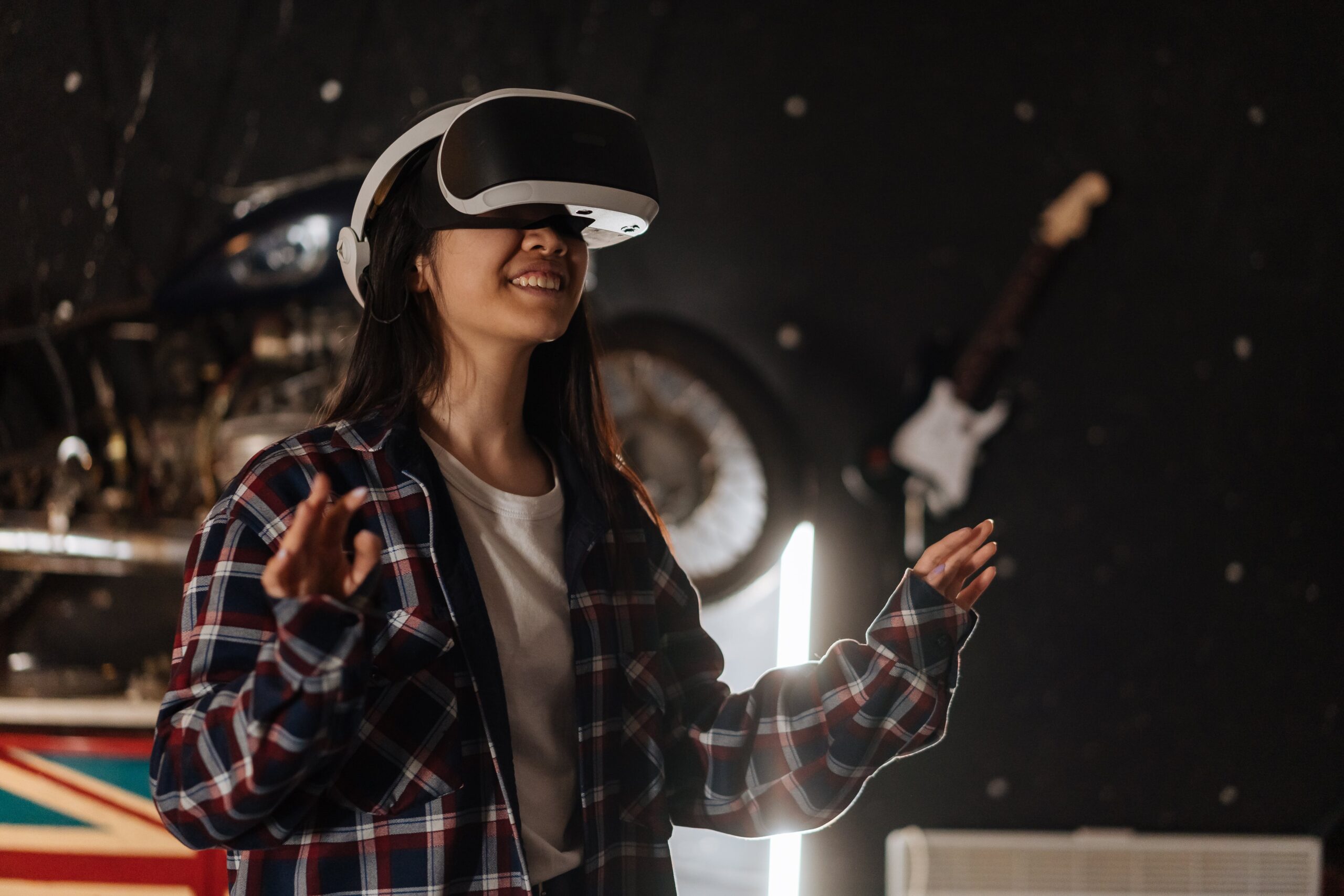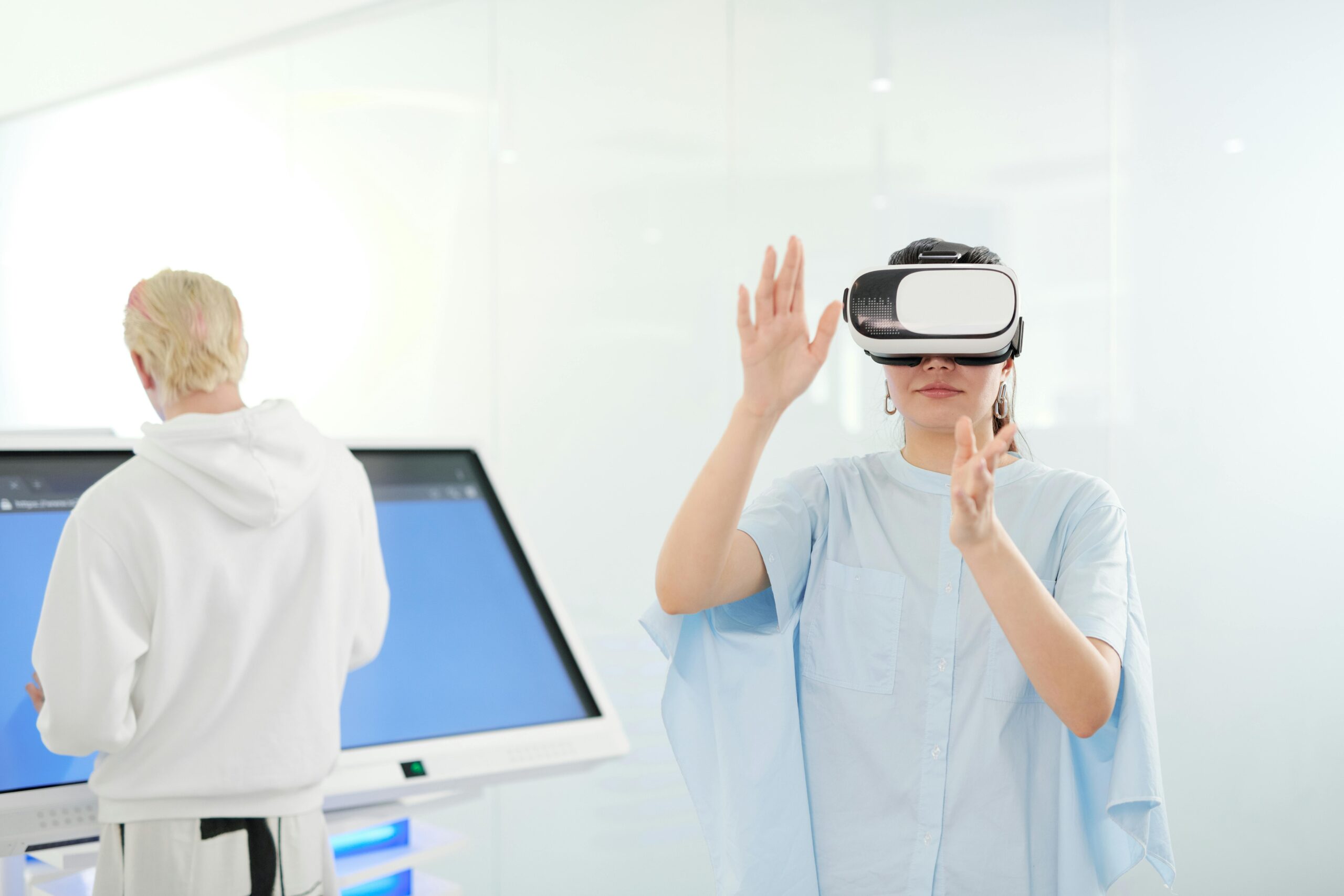
Imagine soaring through the Grand Canyon on a virtual hang glider, learning history by walking alongside dinosaurs, or fixing your car engine with holographic instructions hovering in front of you. Sounds like science fiction, right? Not anymore! That’s the magic of Extended Reality (XR), and it’s rapidly becoming a part of our everyday lives. But hold on to your cowboy hats, folks, because XR isn’t just one thing – it’s an umbrella term for a whole universe of immersive experiences.
Think of XR as a spectrum, with two main players:
- Virtual Reality (VR):
Dive headfirst into completely computer-generated worlds. Put on a VR headset and BAM! You’re battling dragons, exploring distant galaxies, or even attending concerts with friends from across the globe – all from the comfort of your living room. VR is like stepping into a whole new reality, limited only by your imagination (and maybe a few cables).
- Augmented Reality (AR):
This one keeps things real-ish. Think of AR as layering digital elements onto the world around you. Imagine pointing your phone at a historical landmark and seeing it come alive with 3D models and interactive information. Or picture fixing that leaky faucet with step-by-step instructions projected right onto the sink. AR blends the physical and digital seamlessly, making the impossible seem, well, possible.
Components of Extended Reality
The Building Blocks of XR: Behind the Magic
Remember that movie scene where everyone marvels at the special effects, wondering how they pulled it off? Well, XR involves some pretty similar wizardry, but instead of creating illusions on a screen, it transports you (or layers information) directly into your world.
1. Hardware:
This is the gear you strap on or hold to access the XR experience. Here’s the lowdown:
- VR Headsets: These immersive goggles block out the real world and immerse you in a fully virtual environment. Think Oculus Quest, PlayStation VR, or HTC Vive.
- AR Devices: These come in various forms, from smartphones and tablets to special glasses. They overlay digital elements onto the real world you see through them. Think of Pokemon Go or Google Lens.
- MR Headsets: Still in their early stages, these combine VR and AR, allowing you to interact with both real and virtual objects in your environment. Microsoft HoloLens is a leading example.
2. Software:
This is the brains behind the brawn, creating the virtual worlds, animations, and interactive elements you experience. It’s like the movie script for XR, dictating what you see, hear, and interact with.
3. Sensors:
These little guys track your movements and actions in real-time, allowing the XR system to respond accordingly. They’re like the puppeteers behind the scenes, making sure your virtual experience feels real and responsive.
4. Processing Power:
All that visual and sensory data needs some serious muscle to crunch it and create a seamless experience. Think of powerful graphics cards and processors working overtime to make everything run smoothly.
5. Content Creation Tools:
Just like any other medium, XR needs content creators to build the worlds and experiences we explore. These tools allow developers, artists, and designers to bring their imaginations to life in an immersive way.
Applications of Extended Reality
We’ve covered the building blocks, now let’s see how those blocks are being used to build amazing XR applications across different fields:
Healthcare:
- Surgery: Doctors can practice complex procedures in VR before operating on real patients, reducing risks and improving outcomes.
- Therapy: VR can help treat phobias, anxiety, and PTSD by providing safe and controlled exposure to simulated environments.
- Medical education: Students can explore the human body in immersive 3D, making learning anatomy and physiology more engaging and effective.
Education:
- Virtual field trips: Transport students to historical sites, underwater coral reefs, or even the surface of Mars, all without leaving the classroom.
- Interactive learning: Bring textbooks and lessons to life with 3D models, simulations, and augmented reality overlays.
- Skill development: Practice public speaking, lab experiments, or engineering design in immersive VR environments.
Entertainment:
- Gaming: Explore vast open worlds, battle dragons, and compete with friends in truly immersive experiences.
- Movies and concerts: Enjoy live events or watch 360-degree movies as if you’re right in the middle of the action.
- Theme parks: Take rides with augmented reality overlays, interact with virtual characters, and experience next-level storytelling.
Retail and eCommerce:
- Virtual try-on: Try on clothes, makeup, or even glasses virtually before buying, reducing returns and increasing customer satisfaction.
- Product visualization: See furniture in your home before you buy it, or explore car interiors in detail from your phone.
- Interactive shopping experiences: Browse stores virtually, interact with sales reps, and purchase items seamlessly.
Manufacturing and Design:
- Prototyping and design review: Create and iterate on product designs in VR, saving time and materials.
- Remote collaboration: Teams spread across the globe can work together on 3D models in real-time.
- Training and maintenance: Train workers on complex procedures using VR simulations, or overlay instructions onto equipment for efficient maintenance.
XR’s Future: Blurring the Lines Between Real and Virtual
The future of Extended Reality (XR) is brimming with possibilities:
- Miniaturization and integration: Expect sleeker, lighter headsets and glasses seamlessly blending into daily life.
- Haptics and sensory feedback: XR experiences will feel even more real with advanced touch sensations, temperature changes, and even smells.
- Enhanced AI and machine learning: Personalized XR experiences tailored to individual users and preferences will become the norm.
- Focus on accessibility and social impact: XR will strive to be inclusive and address potential social issues, ensuring equitable access and responsible development.
- Merging realities: The lines between AR, VR, and MR will blur, creating hybrid experiences that seamlessly blend the physical and digital worlds.
Key Hardware in Extended Reality
Here are some of the key hardware components in Extended Reality (XR):
1. Headsets:
- VR Headsets: These are the most immersive type of XR hardware, completely blocking out the real world and replacing it with a virtual environment. They typically have two high-resolution displays, one for each eye, and head tracking sensors to allow the user to look around in the virtual world.
- AR Headsets: These headsets overlay digital information onto the real world. They typically have a transparent display in front of one or both eyes, and cameras and sensors to track the user’s surroundings.
2. Glasses:
- Smart Glasses: These glasses look like regular eyeglasses but have built-in displays and sensors that allow them to overlay information onto the real world. They are not as powerful as AR headsets, but they are more lightweight and discreet.
3. Smartphones and Tablets:
- Mobile Devices: Smartphones and tablets can be used for both AR and VR experiences. AR apps use the device’s camera and sensors to overlay digital information onto the real world, while VR apps can be used with a special headset that mounts the device in front of the user’s eyes.
4. Sensors:
- Motion Tracking Sensors: These sensors track the user’s movements and head position, allowing the XR system to update the virtual or augmented environment accordingly. Common types of motion tracking sensors include gyroscopes, accelerometers, and magnetometers.
- Environmental Sensors: These sensors can detect features of the real world, such as light levels, depth, and objects. This information can be used to improve the accuracy and realism of AR experiences.
5. Processing Power:
- Processors and Graphics Cards: XR applications require a lot of processing power to render complex virtual and augmented environments. High-end VR headsets and AR devices typically have their own built-in processors and graphics cards, while mobile devices rely on the processing power of the smartphone or tablet itself.
6. Content Creation Tools:
- Software Development Kits (SDKs): These tools provide developers with the necessary resources to create XR applications for specific hardware platforms.
- 3D Modeling and Animation Software: This software is used to create the virtual objects and environments that users see in XR experiences.
Conclusion
Extended Reality (XR) isn’t science fiction anymore. It’s a rapidly evolving realm where VR, AR, and MR are blurring the lines between real and virtual. From soaring through virtual worlds to fixing cars with holographic guides, XR holds immense potential to transform how we learn, work, and play. While challenges like accessibility and ethical considerations remain, the future of XR is bright, promising immersive experiences that will reshape our reality in exciting ways. So, strap yourselves in, cowboys and cowgirls, the XR revolution is just beginning!
References for Extended Reality:
General XR Information:
- National Academies Press: “Virtual Reality: Scientific and Technological Challenges” (https://nap.nationalacademies.org/catalog/4761/virtual-reality-scientific-and-technological-challenges)
- XR Association: https://xra.org/
- Stanford Encyclopedia of Philosophy: “Virtual Reality” (https://plato.stanford.edu/)
- MIT Technology Review: “Augmented Reality” (https://www.technologyreview.com/)
Specific XR Types:
- VR Hardware: “Meta Quest 2 VR Headset: https://www.meta.com/quest/“
- AR Hardware: “Microsoft HoloLens AR Headset: https://www.microsoft.com/en-us/hololens“
- MR Hardware: “Magic Leap 2 AR Headset: https://www.magicleap.com/buy-now“
FAQs
1. What is extended reality (XR) with an example?
Think beyond your screen! XR refers to a spectrum of technologies that blend the real and virtual worlds. Imagine exploring ancient Rome by walking its streets in VR, or fixing your car with holographic instructions in AR. XR encompasses Virtual Reality (VR), immersing you in fully computer-generated worlds, Augmented Reality (AR), overlaying digital elements onto your real-world surroundings, and Mixed Reality (MR), merging both for truly interactive experiences.
2. Why is extended reality so popular?
XR’s popularity skyrockets thanks to its potential to transform various fields:
Education: Imagine dissecting a frog in VR or exploring the Great Barrier Reef from your classroom! XR makes learning interactive and engaging.
Healthcare: Surgeons practice complex procedures in VR, therapists treat phobias safely, and medical students explore the human body in 3D – XR revolutionizes healthcare.
Entertainment: Battle dragons in VR, watch concerts live in 360°, or take immersive theme park rides – XR brings entertainment to life like never before.
Beyond imagination: The possibilities are endless! From design and manufacturing to retail and social interaction, XR promises to reshape our world.
3. What’s the difference between XR and AR?
XR is the umbrella term, encompassing all technologies that bridge the real and virtual worlds. AR is a specific type of XR where digital elements are added to the real world you see through your device. It’s like a “see-through” screen. VR, on the other hand, completely replaces your real-world vision with a computer-generated environment. Imagine wearing a VR headset and feeling like you’re walking on Mars!
4. Is extended reality a good career choice?
Absolutely! The XR industry is rapidly growing, creating exciting job opportunities across various sectors. From developers and designers to engineers and educators, XR needs diverse talents to shape its future. If you’re passionate about technology, innovation, and pushing boundaries, XR could be your perfect career path. Just remember, like any new field, continuous learning and adapting to fast-paced advancements are crucial.







